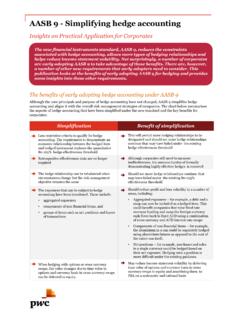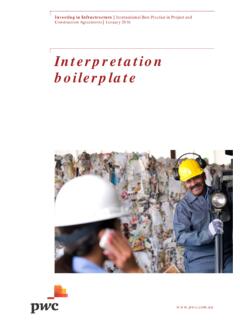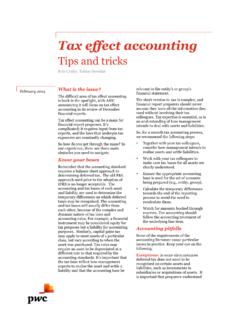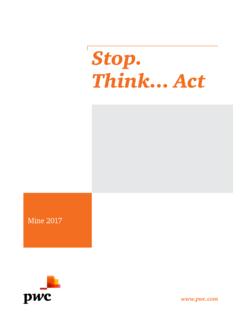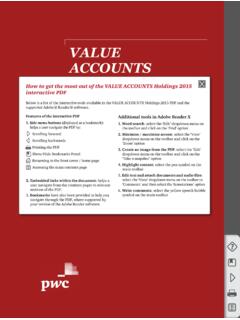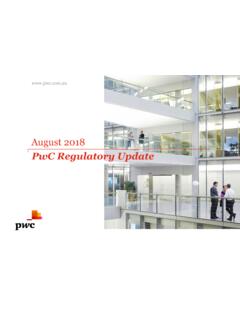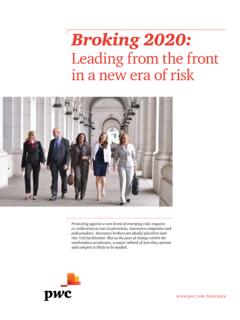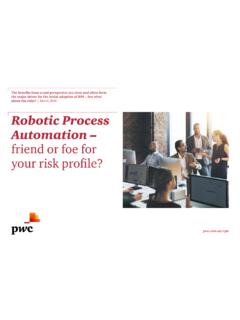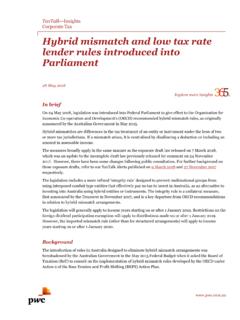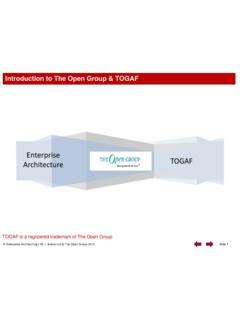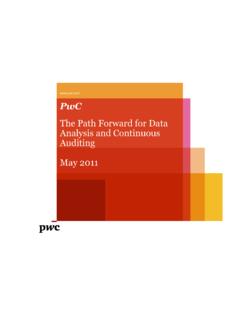Transcription of PwC Risk and Compliance Benchmarking Survey 2017
1 Risk and Compliance Benchmarking Survey10th Annual Survey | August 2017 | This marks the tenth anniversary of our annual look at what is shaping the Risk and Compliance landscape in Australia. PwC surveyed 52 Australian-based Superannuation Funds and Asset and Wealth Managers. We also interviewed numerous executive and non-executive directors and Compliance committee members to bring an additional perspective to this year s spotlight on how risk and Compliance has contibuted to building trust across the Australian Wealth Management sector over the past decade2017 Risk and Compliance Benchmarking Survey | IIIE xecutive summary ..2 Impact of regulation ..4 Data management, cyber security and outsourcing ..10 Culture and conduct.
2 16 Breaches, incidents and complaints ..20 Evolution of risk and Compliance of contentsWho participatedEntity type Superannuation Funds Asset & Wealth ManagersAssets under management<$6bn33%29%25%13%$ $20bn$21bn $50bn>$50bnGeographical locationMelbourne 60%Sydney 30%Newcastle 2%Adelaide 2%Brisbane 6%2 | PwCOur recent PwC/Financial Services Council Chief Executive Officers (CEO) Survey1 also highlighted that the majority of financial services CEOs believe that the burden of regulation is increasing, and are concerned about the cost of Compliance . More worryingly, they are not convinced that current regulations are actually providing the value that customers and members seek, or supporting efforts to earn customers and members trust.
3 It s increasingly clear that industry and regulators need to find other ways to achieve closer collaboration, leading to regulation that adds real value, meets the needs of customers and members, and supports rather than hinders good business, innovation and growth. Over the last decade, we have observed an increasing trend toward industry adopting a heavily outsourced operating model. The challenges this presents has been magnified in recent years due to the volume of data being generated and the increasing expectations to adequately monitor service providers. Further understanding who has access to your data has never been more important, with cyber attacks now part of business as summaryThere have been significant changes in the Wealth Management sector since the Superannuation Industry (Supervision) Act and Managed Investment Act were introduced in the 1990s.
4 Today the sector is the custodian of one of the largest pools of savings in the world, in an ever changing landscape that presents new opportunities and this comes greater scrutiny, both from regulators and the public, which has intensified since the financial crisis almost a decade ago. Over the years, this Survey has highlighted the challenge that the industry has been tasked with, of trying to keep pace with rapidly changing regulations, while simultaneously trying to deliver value for customers and members, including reducing operating costs. This year is no different. We continue to see significant new regulatory requirements being imposed on the industry to provide greater protection and transparency for customers and members.
5 75%Ranked keeping up with regulatory expectations of risk management practices in their top three risk management respondents believe the current Australian regulatory model restricts their competitiveness year on year in the number of respondents having an enterprise wide data management of CEOs were concerned that the rapidly changing regulatory environment is increasing the risk of their organisation not complying with relevant laws and PwC/Financial Services Council Chief Executive Officers (CEO) Survey July 20172 PwC s Risk in Review 2017: Managing risk from the front line for greater resiliency and growth2017 Risk and Compliance Benchmarking Survey | 3 Using FinTech to meet changing customer needs is seen as the number one opportunity for over 70% of of respondents indicated the three lines as defence model to manage risk within their organisations are highly respondents include risk related objectives and metrics in annual performance Y 1755%F Y16 Culture and conduct have always been a key driver of conduct, however it has received increased scrutiny in recent years.
6 There has also been a trend toward using data to more effectively monitor culture and conduct. It is clearly important that the right people do the right things at the right time , yet our Survey suggests measuring culture is still in its infancy for many. Tools to measure culture in the future will combine and analyse current data points and allow organisations to predict behaviours before they constitutes a reportable breach has been debated since our first Survey in 2008. This could explain the lack of any clear trend in the number of breaches and incidents throughout the ten years of Survey effectiveness of the three lines of defence model has been discussed in recent surveys. Today, there is greater emphasis on the first line of the business owning and managing risk and Compliance , with the Risk and Compliance function playing a greater monitoring role.
7 This view is consistent with our 2017 PwC Global Risk in Review Survey ,2 which concludes that shifting risk decision-making to the front line drives higher revenues, faster risk-event recovery and stronger risk a significant pipeline of new regulatory reforms ahead of us, it is critical for organisations to look beyond traditional approaches to managing risk and Compliance . Further, we should continue to remind ourselves of the important role risk and Compliance plays in delivering better outcomes for customers and members. We hope this Survey , and the discussions and debate which follow help contribute to enhancing trust in the and Compliance functions 81%centralised 19 % decentralised37%of respondents do not have policies in place to comply with the new mandatory data breach notification | PwC2001-2003 The Corporations Act 2001 and Australian financial services licence (AFSL) requirements released Government reviews effectiveness of the Managed Investment Act recommending the development of standards relating to qualifications and experience of Compliance committee members2004-2008 Introduction of Registrable Superannuation Entity Licensees (RSE Licencees)
8 Concept requires trustees to demonstrate to APRA that they have adequate resources, risk management systems and skills Anti-Money Laundering and Counter-Terrorism Financing Act 2008 introduces the need to identify and monitor customers, maintain a Compliance program, report suspicious matters and cash transactions and file annual Compliance reports2012-2013 The introduction of APRA Prudential Standards Significant increase in APRA reporting obligations (from 900 to 4,500 plus data points)2014-2015 Introduction of StrongerSuper reforms including MySuper licensing regimes and SuperStream The Federal Government released its response to the 2014 Financial System Inquiry, setting out an agenda for improving Australia s financial system including measures to ensure the Superannuation system is competitive, financial advice standards are lifted and financial regulator accountability and capability is enhanced2016-2017 AUSTRAC published first money laundering and terrorism financing Superannuation sector risk assessment ASIC releases a number of new regulatory guides.
9 Including RG 97 Disclosing fees and costs in PDSs and periodic statements and RG 259 Risk management systems of responsible entities Introduction of Attribution managed investment trust (AMIT) tax regime for registered schemes The Senate passes the Privacy Amendment (Notifiable Data Breaches) Bill 2016 introducing a mandatory data breach reporting regime for the first time from 2017 Government releases consultation draft legislation aiming to improve accountability and member outcomes in SuperannuationImpact of regulationOur point of viewThe Wealth Management sector has largely met regulatory challenges to date, but the real question is whether the sector is resilient enough to withstand the constant start, stop, deferral approach to regulatory change, and continue to thrive?
10 Over the years regulators have in addition to mandated Compliance also imposed a principles and risk based focus. Consequently their engagement has moved from traditional annual visits to constant dialogue in the form of visits, thematic assessments, desktop and deep dive reviews. In the last five years we have seen key industry changes driven by regulation that has resulted in significant shocks to organisations which have continued to be Compliance driven. The introduction of Superannuation Prudential Standards was a significant turning point for organisations to embed a risk led thought process in all decisions. Going forward we expect to see this risk led thought process having more of an impact on organisations strategy and decision making.
